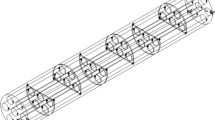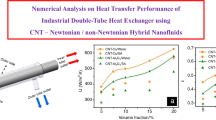Abstract
In this study, a series of low-concentration carbon nanotubes (CNT) water-based nanofluids (0.0055, 0.055, 0.111 and 0.278 vol%) were used as coolants in a shell and tube cooler of the residue fluid catalytic cracking gasoline product to analyze their effects on heat performance of the heat exchanger. The coolants and gasoline flow in tube side and shell side, respectively. This work was performed through simulating the heat exchanger by ASPEN HTFS+ 7.3 software. The performance of the nanofluids to heat transfer was analyzed in comparison with cooling water. Results illustrated that 0.055% CNT concentration could enhance heat transfer properties of the heat exchanger such as Nusselt number, total heat transfer coefficient and heat transfer rate more than other concentrations. Therefore, the lowest temperature of outlet shell-side fluid was also observed at this concentration. Moreover, increment in mass flow rates of both the tube-side and shell-side fluids caused enhancement of the heat transfer, especially with 0.055 vol% CNT. Although there is an optimum concentration among the studied CNT volume fractions, all nanofluids exhibit better thermal performance of the heat exchanger than cooling water, whereas pressure drop increases with CNT loading.























Similar content being viewed by others
Abbreviations
- A t :
-
Flow area of tube side (m2)
- A s :
-
Total heat transfer area of tube outside (m2)
- A cf :
-
Area of cross-flow (m2)
- C min :
-
Minimum specific heat (J kg−1 K−1)
- C p :
-
Fluid specific heat (J kg−1 K−1)
- C μ :
-
Viscosity improvement coefficient
- d i :
-
Inner tube diameter (m)
- d o :
-
Outside tube diameter (m)
- D e :
-
Equivalent diameter (m)
- h ss :
-
Convection heat transfer coefficient for shell-side fluid (W m−2 K−1)
- h nf :
-
Convection heat transfer coefficient for nanofluid (W m−2 K−1)
- h hot :
-
Convection heat transfer coefficient for hot fluid (W m−2 K−1)
- k nf :
-
Thermal conduction for nanofluid (W m−1 K−1)
- k :
-
Thermal conduction for shell-side fluid (W m−1 K−1)
- k w :
-
Thermal conduction for tube (W m−1 K−1)
- m nf :
-
Nanofluid mass flow rate (kg s−1)
- m ss :
-
Shell-side fluid mass flow rate (kg s−1)
- Nu nf :
-
Nusselt number of nanofluid
- Pr nf :
-
Prandtl number of nanofluid
- Pr ss :
-
Prandtl number of shell side
- f :
-
Friction factor
- q :
-
Heat transfer rate (kW)
- T hi :
-
Hot fluid outlet temperature (°C)
- T ci :
-
Cold fluid outlet temperature (°C)
- Re ss :
-
Shell-side fluid Reynolds number
- Re nf :
-
Nanofluid Reynolds number
- U :
-
Total heat transfer coefficient(W m−2 K−1)
- μ nf :
-
Nanofluid viscosity (mPa s)
- μ bf :
-
Base fluid viscosity (mPa s)
- μ ss :
-
Shell-side fluid viscosity (mPa s)
- \(\varphi\) :
-
Nanoparticle volume fraction
- ∆TLMTD :
-
Log mean temperature difference (°C)
- \(\varepsilon\) :
-
Effectiveness of heat exchanger
References
Ozsoy A, Corumlu V. Thermal performance of a thermosyphon heat pipe evacuated tube solar collector using silver-water nanofluid for commercial applications. Renew Energy. 2018;122:26–34.
Nakhchi ME, Esfahani JA. Cu-water nanofluid flow and heat transfer in a heat exchanger tube equipped with cross-cut twisted tape. Powder Technol. 2018;339:985–94.
Budak Ziyadanogullari N, Yucel HL, Yildiz C. Thermal performance enhancement of flat-plate solar collectors by means of three different nanofluids. Therm Sci Eng Prog. 2018;8:55–65.
Kim S, Tserengombo B, Noh J, Choi SH, Huh S, Choi B, Chung H, Kim J, Jeong H. Experimental investigation of heat transfer coefficient with Al2O3 nanofluid in small diameter tubes. Appl Therm Eng. 2019;146:346–55.
Sidik NAC, Yazid MNAWM, Samion S. A review on the use of carbon nanotubes nanofluid for energy harvesting system. Int J Heat Mass Transf. 2017;111:782–94.
Yanwei H, Li H, He Y, Liu Z, Zhao Y. Effect of nanoparticle size and concentration on boiling performance of SiO2 nanofluid. Int J Heat Mass Transf. 2017;107:820–8.
Sarviya RM, Fuskele V. Review on thermal conductivity of nanofluids. Mater Today Proc. 2017;4:4022–31.
Bahiraei M, Rahmani R, Yaghoobi A, Khodabandeh E, Mashayekhi R, Amani M. Recent research contributions concerning use of nanofluids in heat exchangers: a critical review. Appl Therm Eng. 2018;133(25):137–59.
Kumar V, Tiwari AK, Ghosh SK. Application of nanofluids in plate heat exchanger: a review. Energy Convers Manag. 2015;105:1017–36.
Mikkola V, Puupponen S, Saari K, Ala-Nissila T, Seppälä A. Thermal properties and convective heat transfer of phase changing paraffin nanofluids. Int J Therm Sci. 2017;117:163–71.
Sani E, Papi N, Mercatelli L, Żyła G. Graphite/diamond ethylene glycol-nanofluids for solar energy applications. Renew Energy. 2018;126:692–8.
Rashidi S, Kashefi MH, Kim KC, Samimi-Abianeh O. Potentials of porous materials for energy management in heat exchangers—a comprehensive review. Appl Energy. 2019;243:206–32.
Shamsabadi H, Rashidi S, Esfahani JA. Entropy generation analysis for nanofluid flow inside a duct equipped with porous baffles. Therm Anal Calorim. 2018. https://doi.org/10.1007/s10973-018-7350-4.
Rashidi S, Javadi P, Esfahani JA. Second law of thermodynamics analysis for nanofluid turbulent flow inside a solar heater with the ribbed absorber plate. Therm Anal Calorim. 2018. https://doi.org/10.1007/s10973-018-7164-4.
Rashidi S, Akbarzadeh M, Karimi N, Masoodi R. Combined effects of nanofluid and transverse twisted-baffles on the flow structures, heat transfer and irreversibilities inside a square duct-A numerical study. Appl Therm Eng. 2018;130:135–48.
Parizad Laein R, Rashidi S, Abolfazli Esfahani J. Experimental investigation of nanofluid free convection over the vertical and horizontal flat plates with uniform heat flux by PIV. Adv Powder Technol. 2016;27:312–22.
Maskaniyan M, Rashidi S, Esfahani JA. A two-way couple of Eulerian-Lagrangian model for particle transport with different sizes in an obstructed channel. Powder Technol. 2017;312:260–9.
Rashidi S, Mahian O, Languri EM. Applications of nanofluids in condensing and evaporating systems a review. Therm Anal Calorim. 2017. https://doi.org/10.1007/s10973-017-6773-7.
Rashidi S, Eskandarian M, Mahian O, Poncet S. Combination of nanofluid and inserts for heat transfer enhancement. Therm Anal Calorim. 2018. https://doi.org/10.1007/s10973-018-7070-9.
Mahian O, Kolsi L, Amani M, Estellé P, Ahmadi G, ClementKleinstreuer JS, Marshall RA, Taylor HN, Wongwises S, Hayat T, Kolanjiyil A, Kasaeian A, Pop I. Recent advances in modeling and simulation of nanofluid flows-Part I: fundamentals and theory. Phys Rep. 2019;790:1–48.
Rashidi S, Hormozi F, Sundenc B, Mahian O. Energy saving in thermal energy systems using dimpled surface technology—a review on mechanisms and applications. Appl Energy. 2019;250:1491–547.
Barzegariana R, Aloueyanb A, Yousefic T. Thermal performance augmentation using water based Al2O3-gamma nanofluid in a horizontal shell and tube heat exchanger under forced circulation. Int Commun Heat Mass Transf. 2017;86:52–9.
Shahrul IM, Mahbubul IM, Saidur R, Sabri MFM. Experimental investigation on Al2O3–W, SiO2–W and ZnO–W nanofluids and their application in a shell and tube heat exchanger. Int J Heat Mass Transf. 2016;97:547–58.
Hosseini SM, Vafajoo L, Salman BH. Performance of CNT-water nanofluid as coolant fluid in shell and tube intercooler of a LPG absorber tower. Int J Heat Mass Transf. 2016;102:45–53.
Al-Abdali G, Maghrabie HM, Attalla M. Investigation of heat transfer and friction factor of Al2O3 nanofluid inside shell and tube heat exchanger. Sci Eng Res. 2018;5:549–56.
Aghabozorg MH, Rashidi A, Mohammadi S. Experimental investigation of heat transfer enhancement of Fe2O3-CNT/water magnetic nanofluids under laminar, transient and turbulent flow inside a horizontal shell and tube heat exchanger. Exp Thermal Fluid Sci. 2016;72:82–189.
Mahian O, Kolsi L, Amani M, Estellé P, ClementKleinstreuer G, Marshall JS, Taylor RA, Niazmand H, Wongwises S, Hayat T, Kolanjiyil A, Kasaeian A, Pop I. Recent advances in modeling and simulation of nanofluid flows-Part II: applications. Phys Rep. 2019;791:1–59.
Estellé P, Mahian O, Maré T, Öztop HF. Natural convection of CNT water based nanofluids in a differentially heated square cavity. J Therm Anal Calorim. 2017;128(3):1765–70.
Minea AA, Estellé P. Numerical study on CNT nanofluids behavior in laminar pipe flow. J Mol Liq. 2018;271:281–9.
Mohd-Ghazali N, Estellé P, Halelfadl S, Maré T, Choon Sionga T, Abidin U. Thermal and hydrodynamic performance of a microchannel heat sink with carbon nanotubes nanofluids: effect of concentration and channel section. J Therm Anal Calorim. 2019. https://doi.org/10.1007/s10973-019-08260-2.
Halelfadl S, Mare T, Estellé P. Efficiency of carbon nanotubes water based nanofluids as coolants. Exp Thermal Fluid Sci. 2014;53:104–10.
Gnielinski V. New equations for heat and mass transfer in turbulent pipe and channel flow. Int Chem Eng. 1976;16:359–68.
Duangthongsuk W, Wongwises S. Heat transfer enhancement and pressure drop characteristics of TiO2–water nanofluid in a double-tube counter flow heat exchanger. Int J Heat Mass Transf. 2009;52:2059–67.
Author information
Authors and Affiliations
Corresponding author
Additional information
Publisher's Note
Springer Nature remains neutral with regard to jurisdictional claims in published maps and institutional affiliations.
Rights and permissions
About this article
Cite this article
Masoud Hosseini, S., Safaei, M.R., Estellé, P. et al. Heat transfer of water-based carbon nanotube nanofluids in the shell and tube cooling heat exchangers of the gasoline product of the residue fluid catalytic cracking unit. J Therm Anal Calorim 140, 351–362 (2020). https://doi.org/10.1007/s10973-019-08813-5
Received:
Accepted:
Published:
Issue Date:
DOI: https://doi.org/10.1007/s10973-019-08813-5




